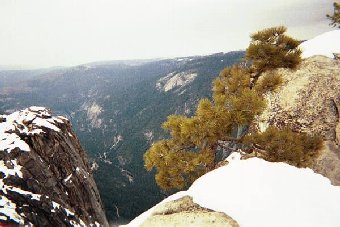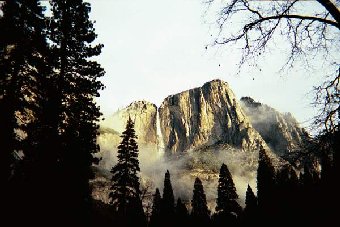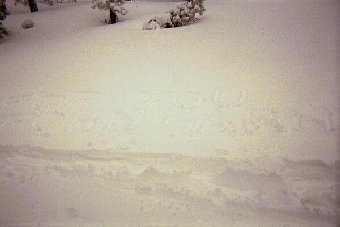Yosemite Valley, CA – Sometimes life is tough and duty calls. In February 2000, as part of my official duties at NASA, I attended the “Yosemite 2000” Conference on Comparative Aeronomy in the Solar System, where both the science and the recreation were excellent. Winter in Yosemite is quiet time. I have been there in September and it was 20 times more crowded than February, and September is after peak season.
The conference sessions ran daily from 7:50 – 11:45 AM and 5:30 – 8 PM. At 12:15 each day there was a free shuttle bus from Yosemite Lodge to Badger Pass ski area. We would eat box lunches on the shuttle bus on the 45 minute trip and typically got skis on snow at 1:15 or so. Another free bus returned us to the lodge at 5:15 leaving just enough time for a quick shower before the evening session. I am proud to report that I did not miss a paper nor fall asleep once in the evening sessions, although many non-skiers did. There was a special afternoon conference rate lift ticket at $5.00, which was partly subsidized by our registration fees. Weekday afternoon lift tickets for the public are $17.00.
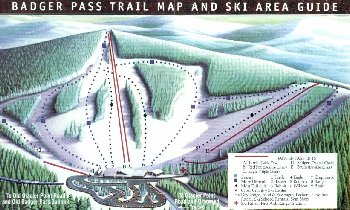
Click on image to open a full-size trail map in a new browser window |
Registration was Monday evening, but I got there at 2 PM and ran up to Badger Pass in my rental car to check things out. It is quite modest: 800 vertical feet, about 10 trails, with a wide open western feel and some interesting rolls and drops. Badger is California’s first ski area, established in 1935; Sugar Bowl, at the north end of Lake Tahoe, began in 1938.
The floor of Yosemite Valley is at 4000 feet elevation; Badger Pass base is at 7200 and lift tops out at 8000. On Monday afternoon it was about 60ºF at the base and I decided to climb on my Bushwackers (waxless fat XC skis). Based on advice from the Nordic Center, I went up the side of the downhill area through very heavy, badly postholed Sierra cement and took one run down. It had not snowed for a week at this point, but the snow depth was at least 4 feet. Skiing down in that stuff with little skis & boots was hard work, and I took some hard falls. The major purpose was to look around and send my body a message – be prepared to work hard at 8000 feet – so I was not at all disappointed. The views were magnificent and I was excited by the backcountry possibilities.
When I got back to the valley, the sides of my empty water bottles were compressed to about 2/3 their normal size by the pressure difference.
On Tuesday, the first full conference day, I decided to be social, get to know my fellow conferees, and lift ski. It was another 50 – 60 degree sunny day, and the trail conditions must be described as hero snow. Only about 8 conferees
out of 100 went up to ski since the valley was even warmer and people simply did not believe that there was snow. I skied with 5 or 6 of the others, and then left the trails for the little bit of tree skiing that was visible. It was short but steep; the trees were not tight but the “Sierra cement “ was heavy enough to make it a challenge anyway. In truth, it was leg breaking crud, and after two runs I decided that it wasn’t really worth risking my ski career and went back to groomed terrain.
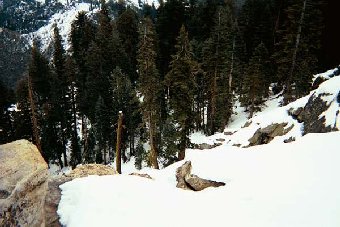
Dewey Point – almost there!
On the edge at Dewey Point |
I met a fellow free heel skier in a patrol jacket and we paired up for the rest of the day. He was a good skier and I enjoyed his company. He was interested in the Mad River Glen bumper sticker on my skis and vowed to make it there some day. Brian, my offer to show you around Mad River is good any time.
Much as I enjoy skiing at a previously unvisited area, I was really excited about the idea of backcountry skiing in this unique setting. Wednesday dawned cool and cloudy in the valley, promising snow at 7000 ft., so I decided to go cross country skiing. Badger Pass ski area is on the road to Glacier Point, a spectacular promontory overlooking the valley that I have visited in summer. In winter the road is closed beyond Badger Pass and the final 10.5 miles of the road to Glacier Point is used as a cross country ski trail. Given that the bus didn’t get there until 1:15 and would leave for the valley at 4:30, Glacier Point, at 21 miles round trip, was out of the question. I went to the Ranger station at the “A-frame hut”, asked some questions and bought a trail map for $0.50. By this time it was 1:45 and I set out for Dewey Point, another high point overlooking the valley and 7 – 8 miles round trip. I set a turn around time of 2:45. On the first mile on the groomed track the wide short waxless skis were real dogs and I kept getting passed by folks on traditional long skinny skis. There seemed to be dozens of them; it was like a wide sidewalk in a big city. After a mile or so I turned left onto the ungroomed trail to Dewey Point, it began to snow, and soon I was alone in a wilderness.
The trail first went through a meadow and then began to go up and down, snaking through giant trees. On the west side of the Sierras and Cascades rain falls in copious amounts and supports a temperate rain forest. Spruce and fir trees
commonly reach 150 ft. high with 4 – 6 foot trunk diameters. It’s an amazing experience for an easterner.
I was pushing too hard to properly enjoy the view but wanted to get to the point. At 2:45 I saw a sign on a tree that said it was still 1 mile away. I decided to push on, having made a decision that it would be OK to miss the bus back to the valley. I had packed a headlamp, matches, space blanket, two-mile whistle, six power bars and three liters of water. I could probably hitch a ride if I missed the bus, and I might never be here again.
Within minutes I reached the point. It arrived quite suddenly, and in a white out it would have been possible to ski right off the edge without knowing it. I don’t really know how long the drop is, but you’d have plenty of time to kiss your butt good bye. The first realization was that I was standing on snow, six feet or less from a sheer drop of 1000 feet or more. This might be the top of a cornice that could break through at any second. I saw rock two steps away so I stepped there, then took most of the 27 pictures in the disposable camera in just a few minutes. Visibility was degrading steadily and when I started back at 3:10, it was almost a total white out.
Going back was much easier; perhaps it was slightly downhill or perhaps it was euphoria over being in such a magnificent place. I kept stopping and turning around with the hope and feeling that I might be stalked by a mountain lion. They are now quite common in California and the Yosemite literature contained instructions on what to do; stand your ground, stand on a rock or log to get tall and big, throw things, and fight if necessary. Mountain lion, wolf, grizzly,
and polar bears are the only large north american mammals that I have not seen in the wild.
But it was not to be, and I was back to the bus with 15 minutes to spare, all charged up and excited about the day’s trip and the prospects for even better as the next Pacific storm came in and the snow line dropped.
On Thursday the valley was overcast, drizzly and much cooler. I was sure that Badger Pass, at 3200 ft. above the valley would have six inches or more of new snow and indeed the bus driver had to stop and chain up at the 6000-foot level. When we got to Badger Pass it was snowing hard with a stiff wind.
I had decided to use my fat skis and ski up with wax if possible; I had been very impressed in West Virginia two weeks before with the way folks had climbed with wax even with big alpine cambered skis. I was told to use a wax two or three
colors warmer than one would use with nordic cambered skis. It was 25-30ºF, just below the freezing point, so I crayoned on a healthy dose of Red and tested it for grip. The skis would not hold at all; it was almost as if I had no wax,
so I put on the climbing skins and started up, hoping that the skin glue would not be degraded by the wax.
The first pitch of about 500 ft. altitude gain did not appear that steep but it was an amazingly tough piece of work. I had to elevate my heels with climbing bars and stop briefly to catch my breath after every 100 steps. Skins are not that heavy, but the tops of the skis were covered with four inches of heavy wet snow and seemed to weigh 20 pounds apiece. At least there was no backslipping. After about 30 minutes of this, I reached a plateau and decided to take off the skins and try the wax again. This time, for whatever reason, it worked; I did not question the reason, but instead just crossed the plateau and started up the lesser grade to the summit.
The snow was drier and the skis even had a little glide, making the going almost easy. I was now following a service road and just before reaching the summit a ski patroller for the downhill area came roaring up on a snowmobile. I flagged him down to ask some questions. He said that 1/4 mile out a ridge, beyond the lift served slopes, was a beautiful fairly open area called Tempo Dome, where the original 1930s rope tow had been. Then he added, it’s great when the snow is good but a couple of patrollers were there today; the snow is terrible and the skiing sucks. He was very friendly and helpful, as was everybody at Badger Pass; the place has a real skier’s feel. He wanted to know where I would be,
and when I’d return, and also wanted to be sure that I had climbing skins. After cautioning to not go down too far for fear of reaching Highway 41, he said to have a great time. I did.
By now, it was snowing hard enough that I could not see Tempo Dome, and being alone I decided to just go straight ahead off the flat lift unloading area. It was amazing, a mere 100 ft. beyond the rope that marked the lift area boundary,
the slope rolled over and I dropped out of sight into a private world. Sight and sound were muffled by the falling snow and I could not see or hear another soul. It could have been 1000 miles away from civilization. The snow was stiff heavy powder with a consistency I have never before experienced. It had the feel of wet sand just beyond the highest point the waves reach on a beach. It would not allow the skis to move sideways at all, every turn had to be carved and turns were as hard to finish as they were to start. The best way to do it was to jump on the skis, bend them into reverse camber and put them on edge at the same time. Turns using the sidecut alone had too big a radius and would get you going too fast. Near white out conditions made it difficult to judge the contours of the slope and I got dumped several times by surprise drop-offs that I never saw.
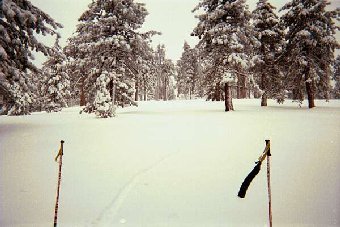
The author’s signature
Yosemite Falls
Tribute in the Snow |
Call me a pervert, but I like difficult conditions, white outs, and skiing by feel. The slope was mild and open, but you still had to pay attention. It was littered with fallen trunks of huge conifers and their sharp broken branches stuck up through the snow. In Vermont, where I do a lot of skiing, standing trees are the major hazard, here it was the deadfall. One of those branches could go through your ribcage or abdomen like a sword. I skied down 500 – 600 vertical feet and climbed back up twice, then skied down to catch my bus as the snow intensified, stopping at the patrol shack to let them know I was safely out.
On Friday morning, the cars and parking lot at Yosemite Lodge were covered with an inch of snow and frozen rain. This time the bus driver had to chain up at the 5000 ft. level, and the snow at Badger Pass was light and dry. I took a single lift ride to the top, told the same patroller in the lift shack that I was going back for more and would let him know when I was safely out at about 4:00. This time the snow allowed any kind of turn I wanted, it was powder paradise. There was occasional light snow and between squalls, a little sun and spectacular views of the valleys. I got in four runs, going down a little further each time.
On Thursday evening I learned that back home my friend John Garner, entrepreneur, skier, pilot, Eagle Scout, and outrageous character had skied off into the sunset. I am not very good at knowing what to say in such situations, but I was struck by the inspiration to scribe a tribute to him in the snow and take a picture; he would have enjoyed being in this place. The thought crystallized my feelings and I had trouble focusing the camera. The light barely allowed a picture and falling snow soon removed my tribute.
Every time I go backcountry skiing I learn something new. Perhaps it’s the nature of the game or perhaps it’s that I’m still fairly new at it. When you work so hard to earn turns, you learn quickly what is efficient and what isn’t. This time the revelation was how much easier it is to follow a set uptrack as compared to breaking trail. It must have been three times easier in the day’s conditions. After the initial discovery I was careful to quickly find and then follow my own uptrack after each descent. Once again I had a private playground and first tracks on every run. At 4:00 I found my ski patrol friend, said goodbye, and skied down.
Lift served Badger Pass is a modest area ideally suited for families, but I probably would not return for that alone. The surrounding backcountry is more than worth a return visit. Next time I will ski to the Ostrander Lake Hut, about eight miles away from the road, and stay a few days to ski the surrounding steep slopes. Reservations can be made at the ranger’s A-frame hut at the base of the Badger Pass lifts on a first come first served basis.
While I have a clever gizmo to velcro my camera to a ski pole and take a self portrait, somehow it didn’t seem right. Yosemite was the star of this show and that is as it should be.

